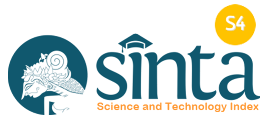EVALUASI DESAIN ANTARMUKA (INTERFACE) PADA SITAKA POLITEKNIK NEGERI SEMARANG
DOI:
https://doi.org/10.24269/pls.v7i2.3535Abstract
Evaluasi desain antarmuka (interface) merupakan bagian dari desain interaksi pada Human Computer Interaction (HCI). Penelitian ini menggunakan metode pendekatan analisis kualitatif. Fokus penelitian ini ada pada desain antarmuka SITAKA (Sistem Informasi Perpustakaan) Politeknik Negeri Semarang. Tujuan penelitian ini adalah untuk mengetahui lebih mendalam mengenai kemudahan (usability) sistem informasi tersebut. Pengumpulan data dilakukan dengan melakukan observasi dan kajian pustaka sumber yang relevan dengan kajian. Hasil penelitian ini menunjukkan bahwa desain antarmuka (interface) SITAKA Politeknik Negeri Semarang cukup baik dalam memberikan kemudahan bagi pengguna pemula dan pengguna ahli di lingkungan Politeknik Negeri Semarang. Namun penambahan fitur juga perlu dilakukan agar aplikasi tersebut lebih baik
Â
References
Firman, A., Wowor, H. F., & Najoan, X. (2016). Sistem informasi perpustakaan online berbasis web. Jurnal Teknik Elektro dan Komputer, 5(2), 29-36.
Garland, J. (2018). Current technology trends in libraries. Petra Paraschiv
Lahut, A. A. (2022). Perancangan Sistem Informasi Perpustakaan Daerah Kota Masohi Berbasis Web (Other Thesis, Universitas Komputer Indonesia) https://elibrary.unikom.ac.id/id/eprint/7519/
Mailasari, M. (2019). Sistem informasi perpustakaan menggunakan metode waterfall. Jurnal Sisfokom (Sistem Informasi Dan Komputer), 8(2), 207-214.
N. DaIimunthe, F. Nazari, K. Purba, and A. Adawiyah,(2019) “EVALUASI WEBSITE PEMKO PEKANBARU MENGGUNAKAN METODE HEURISTIC EVAIUATION,â€Jurnal IImiah Rekayasa dan Manajemen Sistem Informasi, voI. 5, no. 2, pp. 245–250, 2019
Nielsen, J., (1995, januari 1). 10 Usability Heuristiks for User Insterface Design. http://www.useit.com/papers/Heuristik/Heuristik_list.html. Diakses pada tanggal 20 April 2019.
Nielsen, J. 2001. Error Message Guidelines. [online] Tersedia di: <https://www.nngroup.com/articles/error-message-guidelines/>
Nielsen, J. 2008. American English vs. British English for Web Content.[online]Tersedia di: <https://www.nngroup.com/articles/american-vs-british-english-for-web/>
Parlangeli, O., et al. (1999). Multimedia Systems in Distance Education: Effects of Usability on Learning," Journal of Interacting with Computers, 12.
Preece, J, Rogers, Y, & Sharp, H. (2002). Interaction Desain: Benyond Human-Computer Interaction. Jhon Wiley & Sons, Inc.
RAHMAWATI, Nurul Alifah; BACHTIAR, Arif Cahyo (2018). Analisis dan perancangan sistem informasi perpustakaan sekolah berdasarkan kebutuhan sistem. Berkala Ilmu Perpustakaan dan Informasi, [S.l.], v. 14, n. 1, p. 76-86. ISSN 2477-0361. doi:https://doi.org/10.22146/bip.28943.
Ridwan, A. (2007). Pengukuran Usability Aplikasi Menggunakan Evaluasi Heuristik. Jurnal Informasi Komputer.
Savitri, P., dkk. (2015). Review Desain Interface Aplikasi SOPPOS menggunakan Evaluasi Heuristik. Jurnal SIMETRIS, 2015.
Smith, J. A. 2015. Qualitative Psychology: A Practical Guide to Research Methods. [online] Tersedia di: <https://books. google.co.id/books?id=lv0aCAAAQBAJ&dq=what+is+qualitative+methods&lr=&hl=id&source=gbs_navlinks_s>
Sulistyo, Basuki. (1991). Pengantar Ilmu Perpustakaan. Jakarta: Gramedia Pustaka Utama.
Supriyanto, Wahyu. (2008). Teknologi Informasi Perpustakaan. Yogyakarta: Kanisius.
Downloads
Published
How to Cite
Issue
Section
License
Licence
This Journal will place Author as Copyright Holder, The non-commercial use of the article will be governed by the Creative Commons Attribution license as currently displayed on Creative Commons Attribution-NonCommercial-ShareAlike 4.0 International License.

Author(s)' Warranties
The author warrants that the article is original, written by stated author(s), has not been published before, contains no unlawful statements, does not infringe the rights of others, is subject to copyright that is vested exclusively in the author and free of any third party rights, and that any necessary written permissions to quote from other sources have been obtained by the author(s).
Plagiarism Notice
PUBLIS Editorial board recognizes that plagiarism is not acceptable and therefore establishes the following policy stating specific actions (penalties) upon identification of plagiarism/similarities in articles submitted for publication in PUBLIS. PUBLIS will use Turnitin's originality checking software as the tool in detecting similarities of texts in article manuscripts and the final version articles ready for publication. A maximum of 30% of similarities is allowed for the submitted papers. Should we find more than 30% of the similarity index, the article will be returned to the author for correction and resubmission.

_baru.png)










